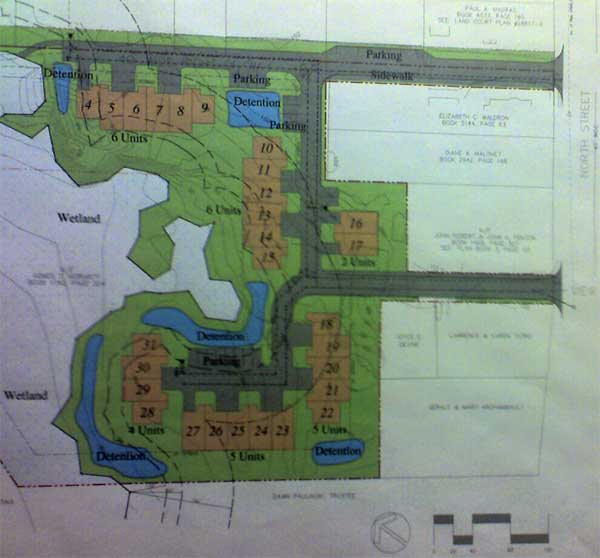The Post and Courier of Charleston, South Carolina, has prepared an excellent flash slideshow comparing natural wetlands with man-made substitutes. The presentation is 4 minutes and 16 seconds long, and has no audio component. The pictures speak for themselves. Here are some of the highlights:
See also:
Kohl Construction Condo Plans Call for Five Detention Pools

EPA: Do Stormwater Retention Ponds Contribute to Mosquito Problems?
Mosquito proliferation in stormwater ponds is a concern, especially when so many wet and dry ponds are in place and continue to be installed across the country. Many ponds are not properly maintained, particularly in cases where they are installed in subdivisions and other developments where the entity responsible for long-term maintenance is not clearly defined once the construction is complete…
Gazette: Erosion Near New Southampton Subdivision: Detention Basin Under Scrutiny
Boxborough Wetlands Regulations: Plans that Require Replication Discouraged
The history of wetland replication is mixed. Scientific reviews [Brown, S&P Veneman, 1998] conclude that for the most part replications fail to reproduce the range of values–in quantity and quality–of the wetlands they are intended to replace, in particular, difficulties in replicating proper hydrological conditions in a consistent and enduring fashion seem to be a major source of the problem.
The Commission shall strongly discourage any plan that requires wetland replication…
4 min 4 sec from the end of the presentation
“Though biologically rich and diverse, isolated wetlands do not receive protections under the Clean Water Act.”
3 min 15 sec from the end of the presentation
“The mild acidity of many of these Lowcountry wetland waters makes them inhospitable to mosquito larvae.”
3 min 9 sec from the end of the presentation
“…a tiny isolated wetland… Though waters do not flow into these wetlands, their waters are kept clear through the oxygenation of lilies and other plants found within their depths.”
3 min 0 sec from the end of the presentation
“Jake Duncan, a former wetlands expert for the Army Corps of Engineers, rests amid the longleaf pines. Builders and the corps have given a lack of consideration to isolated wetlands, he said. ‘We thought at one time that we needed to permit out the small wetlands. Well, after permitting them all away, they’ve become rare things.'”
1 min 9 sec from the end of the presentation
“A sheen of oil covers a portion of the stormwater retention system at Towne Centre in Mount Pleasant. The system is designed to capture leaking motor oil, antifreeze, brake dust, fertilizer and other urban runoff from impervious surfaces such as pavement. Under federal guidelines, this pond is considered a man-made wetland.”
1 min 1 sec from the end of the presentation
“A stormwater pond is filled with algae at Towne Center at Mount Pleasant.”
0 min 53 sec from the end of the presentation
“Everett stands at the edge of a murky stormwater retention pond in Ivy Hall that Everett said was once a forest-lined isolated wetland. While the low grass held carnivorous sundew plants, the stump-filled water was largely devoid of visible aquatic life. ‘This looks awful,’ she said.”
0 min 45 sec from the end of the presentation
“Everett points to a patch of algae growing along the banks of a stormwater retention pond at Belle Hall Plantation in Mount Pleasant. Though the pond is aerated by a fountain, heavy flows of fertilizers can contribute to the algae’s growth…”
0 min 37 sec from the end of the presentation
“A band of white pollutants and algae float at the top of a stormwater retention pond at Belle Hall Plantation. Though created to handle pollution and often full of mosquito larvae, this type of pond is considered a functioning wetland under definitions by the U.S. Department of the Interior.”
See also:
Kohl Construction Condo Plans Call for Five Detention Pools

EPA: Do Stormwater Retention Ponds Contribute to Mosquito Problems?
Mosquito proliferation in stormwater ponds is a concern, especially when so many wet and dry ponds are in place and continue to be installed across the country. Many ponds are not properly maintained, particularly in cases where they are installed in subdivisions and other developments where the entity responsible for long-term maintenance is not clearly defined once the construction is complete…
Gazette: Erosion Near New Southampton Subdivision: Detention Basin Under Scrutiny
Boxborough Wetlands Regulations: Plans that Require Replication Discouraged
The history of wetland replication is mixed. Scientific reviews [Brown, S&P Veneman, 1998] conclude that for the most part replications fail to reproduce the range of values–in quantity and quality–of the wetlands they are intended to replace, in particular, difficulties in replicating proper hydrological conditions in a consistent and enduring fashion seem to be a major source of the problem.
The Commission shall strongly discourage any plan that requires wetland replication…